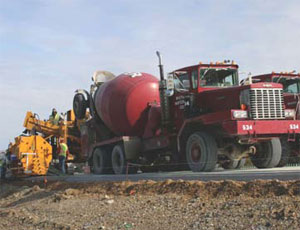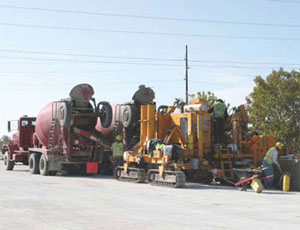... completely replaced the pavement, added one lane in each direction, replaced eight bridges, added four new bridges, built 23 retaining walls and built or rebuilt 10 noise barriers.


Work on this section started in mid-February and must be finished by mid-December. Walsh is self-performing about 50% of this work and subbing the remainder to local contractors.
“This is a challenging project with a fast pace,” says Patrick Goggin, Walsh’s project manager for both of its current I-94 projects. “We’re working well with the WisDOT management team and meeting all the deadlines. For example, we proposed an alternate method for maintaining traffic flow through the work area that eliminated the need to build temporary lanes yet was just as safe as the originally specified method. WisDOT approved the change, and we saved a month of construction time.”
Repaving I-94 includes tearing out the existing pavement, which was originally laid more than 40 years ago, and replacing it with the state’s new standard pavement for Interstate highways.
The new pavement starts with a durable subgrade of 13 in. of select crushed material. On top of that goes a 3-in. layer of asphaltic base material that forms a solid, stable, level “tabletop” on which to build the roadway.
Six in. of crushed aggregate base course is laid and compacted atop the asphaltic tabletop before the roadway is finished with 12 in. of high-performance concrete pavement connected by corrosion-resistant zinc-coated dowel bars.
The pavement should have a structure life of about 75 years, according to William Mohr, WisDOT’s major projects manager for southeastern Wisconsin freeways.
A new safety feature seeing one of its first uses in Wisconsin on the I-94 project is a single-slope concrete median barrier that the state has adopted as its new standard. Mohr says the new barrier provides improved safety, based on roadside design research and national crash-testing standards. He says it also is easier to construct, requires less maintenance and allows more pavement overlays than the previous barrier design.
“Double-u” entrance and exit ramps are two more “first uses in Wisconsin.” Located at the 27th Street interchange in Milwaukee, these long, looping ramps cross over the freeway and will look something the twin loops of a shoelace bow. They will improve safety by eliminating two lights and allowing drivers to enter and exit the freeway using only right-hand turns.
WisDOT expects to put more I-94 work out for bid this summer, including three cut-and-cover tunnels with a total value of $190 million to $210 million. According to Adrian Lopez, WisDOT construction mega-manager for the I-94 project, the tunnels will range from about 600 to 755 ft long and will replace a total of about 10 bridges.
WisDOT projects that the I-94 reconstruction will provide more than 3,000 total jobs during its eight-year life span.

Post a comment to this article
Report Abusive Comment